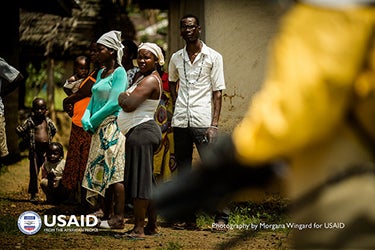Presenters taking part in this afternoon’s session on “Programming for Maternal and Newborn Health during Emergencies: Lessons Learned from Epidemics and Conflict” addressed questions of securing maternal and newborn health services across diverse contexts: the Ebola outbreak in Sierra Leone and Liberia, to conflict in Sudan and South Sudan, and the aftermath of Typhoon Haiyan in the Philippines.
 The first presenter, Paul Pronyk, of UNICEF, pointed to two critical themes: resilience and trust, as fundamental to the experience of addressing the Ebola outbreak in Sierra Leone. These themes: the importance of a health system capable of withstanding shocks and delivering services, and the need to establish trust between communities and health services, were consistent themes throughout the session, even as presenters explored diverse contexts, forms of emergency, and dimensions of maternal and newborn health. The need to build resilience was particularly stark in the case of both Sierra Leone and in Rose Macauley of JSI Research and Training’s presentation on Liberia – of controlling the Ebola outbreak – and the indirect effects of the decimation of health system, which put pregnant women, newborns and children at particular jeopardy from common causes. With understaffed and under-resourced health systems, both countries’ health systems were easily overwhelmed by Ebola in many ways, including its disproportionate effect on health workers. The issue of trust was also especially clear in these contexts, as shown by the reactions in both countries, as people were reluctant to seek care for Ebola or use other services out of fear of health center conditions, confusion over messages about how to care for the sick. In addition, as Macauley highlighted, effective, careful engagement with community members, accompanied by clear messages, made a difference in facilitating the control of the Ebola outbreak in Liberia – an important lesson for direct emergency response and broader maternal and newborn health programming alike.
The first presenter, Paul Pronyk, of UNICEF, pointed to two critical themes: resilience and trust, as fundamental to the experience of addressing the Ebola outbreak in Sierra Leone. These themes: the importance of a health system capable of withstanding shocks and delivering services, and the need to establish trust between communities and health services, were consistent themes throughout the session, even as presenters explored diverse contexts, forms of emergency, and dimensions of maternal and newborn health. The need to build resilience was particularly stark in the case of both Sierra Leone and in Rose Macauley of JSI Research and Training’s presentation on Liberia – of controlling the Ebola outbreak – and the indirect effects of the decimation of health system, which put pregnant women, newborns and children at particular jeopardy from common causes. With understaffed and under-resourced health systems, both countries’ health systems were easily overwhelmed by Ebola in many ways, including its disproportionate effect on health workers. The issue of trust was also especially clear in these contexts, as shown by the reactions in both countries, as people were reluctant to seek care for Ebola or use other services out of fear of health center conditions, confusion over messages about how to care for the sick. In addition, as Macauley highlighted, effective, careful engagement with community members, accompanied by clear messages, made a difference in facilitating the control of the Ebola outbreak in Liberia – an important lesson for direct emergency response and broader maternal and newborn health programming alike.
Lisa McCarthy Clark of Stoneybrook University further highlighted the potential that effective MNH interventions can hold for building communities’ trust in health services. In her presentation on a multi-year effort to train and integrate the use of the Helping Babies Breathe approach into training for midwives in Sudan, she highlighted the changing views of women and community members as they saw the impact of this simple intervention.
Victor Guma of MCSP, whose presentation underscored the fact that “it is possible to deliver these services, even in a setting like South Sudan” as he described a large-scale effort to deliver reproductive and maternal health services that used the Minimum Initial Service Package for Sexual and Reproductive Health (MISP) as a guiding element. He noted that the MISP’s implementation had been fragmented as diverse organizations, working in very challenging settings sought to use it to guide a comprehensive, community-engaged approach, but that this approach helped to build trust with communities. However, he noted, the question of resilience in South Sudan was not only a fundamental challenge, but one that would require both planning ahead to ensure that funding and other resources would be more quickly leveraged in future crises.
Mariella Castillo of UNICEF presented a case in contrast to the others: in a setting where typhoons are increasingly the norm, she described how in spite of the devastation to infrastructure, transportation and communications, and the direct effects on health workers living in the area, a well-coordinated response in the Philippines was able to respond and quickly shift to recovery in the weeks and months after the typhoon struck. As she reported that across a number of indicators of availability of quality maternal and newborn health care, facilities were able to deliver care at a high level within just a few months of the typhoon, thanks in part to the training of staff and preparation for such disasters. This example of resilience further underscored a third theme: the need for appropriate information and, further, the case for “mainstreaming” of research in emergencies as a component of a realistic approach to preparation and planning for future shocks.
Photo: “Liberian woman watches a member of the ambulance team suit up in PPE” ©2014 Morgana Wingard / USAID, used under a Creative Commons Attribution-NonCommerical 2.0 license.
